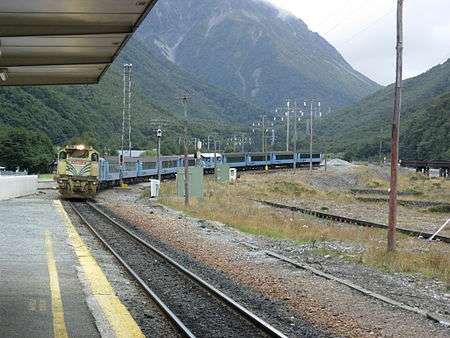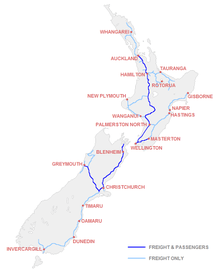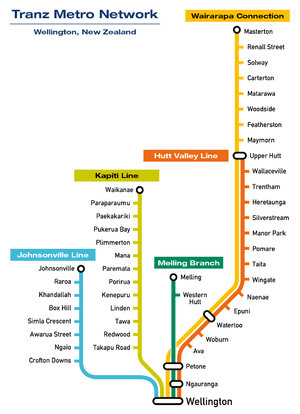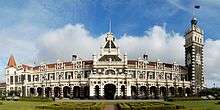Rail travel in New Zealand
New Zealand by rail can be a great way to see both the North and South Islands. New Zealand's passenger rail lines include both the government-owned KiwiRail, as well as heritage and steam lines throughout the country. Commuter train services operate in the Auckland and Greater Wellington region.

Understand
Although rail travel had historically played a much more prominent role in New Zealand's transportation system, with the advent of private car ownership and commercial air travel in the decades following World War II, the popularity of rail travel declined sharply. Today, New Zealand's rail network is only a shadow of its former self, and is primarily used for freight transport. Many former passenger lines have either been dismantled, or are now used exclusively for freight.
New Zealand's long-distance rail network is considerably underdeveloped by the standards the developed world. There are no high-speed services, and driving yourself often works out to be faster than taking the train. The rail network is also relatively limited, with only 3 long distance passenger lines, all operated by state-owned KiwiRail. There is no fixed rail (or road) link between the North and South Islands, with passengers and freight wagons transferred by ferry between Wellington and Picton.
That being said, a train ride from Auckland to Christchurch (with a ferry for crossing between islands) is undoubtedly a unique way to experience New Zealand's stunning landscapes, and would allow you to take in the sights from certain stretches that are difficult to access by car.
History
New Zealand's first railway opened in 1863 between central Christchurch and a temporary port at Ferrymead; the full line opened to Lyttelton in 1867 with the completion of the Lyttelton Rail Tunnel. Over the next 100 years, the rail network expanded to cover the country, however progress was slow due to difficult terrain. The line between Auckland and Wellington was completed in 1908 when railheads met between National Park Village and Ohakune, and the line between Christchurch and Greymouth was completed in 1923 with the opening of the 8.55 km (5.31 mi) Otira Tunnel under the Southern Alps main divide. Two world wars, the Great Depression and difficult terrain meant it took until 1945 for the line between Christchurch and Picton to be completed. The final link in the rail network came in 1962 with the commencement of roll-on-roll-off rail ferry services between Wellington and Picton. The first mainline diesel locomotives were introduced into service in 1954, with the last steam locomotives withdrawn from revenue service in October 1971.
Many rural branch lines closed in the latter half of the 20th century due to competition from road transport. Passenger services were cut back as car ownership rose and air travel became more affordable, although several services were retained and re-branded as tourist services. Auckland's suburban rail network was nearly scrapped in the late 1980s due to low passenger numbers. Wellington's suburban network experienced a decline, but passenger numbers remained strong. This was due to the city's geography being ideal for rail transport and the fact the network was electrified (completed 1938-40 and 1953-55).
In 1993, the government under Prime Minister Jim Bolger privatised the whole rail network. Privatisation was soon deemed an abject failure and it brought worsening quality of service and state of infrastructure, swinging the political consensus in favour of renationalisation. In 2004, the government under Prime Minister Helen Clark bought back the rail infrastructure assets and later in 2008, bought back the remainder to form the present day KiwiRail.
In 2003, the rail renaissance in Auckland began with the opening of a new underground central terminus, Britomart. In 2014-15 the Auckland network was electrified and for the first time, total passenger boardings exceeded those of Wellington. The renaissance has unfortunately caused demand to outstrip the capacity of Britomart station and in 2016 works started on a new rail tunnel through central Auckland to turn Britomart into a through station.
Pros & cons
The advantages of train travel in New Zealand are many:
- You can enjoy the unique New Zealand scenery, including some vistas unavailable by car.
- You can bring large equipment, such as surfboards, mountain bikes, or gear that would be too big to place on a bus or in a small car.
- Trains offer daily service through many small towns. It is possible to get off, enjoy the town, then continue your journey by train the next day.
- You can get a snack or a drink -- on board the train itself.
- New Zealand trains are designed with photographers and sightseers in mind, with outdoor viewing platforms and panoramic viewing lounges in each train. Although there have been no accidents due to leaning out of the viewing platform in the decade they have been operating (and there are barriers that would make it hard to do so very far) in March 2019, KiwiRail decided close the platforms to passengers until further notice.
- All long-distance New Zealand trains have a guide on board who explains the history of each area and points out special things to see. Commuter trains have a train manager (conductor) who collects tickets and can provide you with some local information.
- You can enjoy the ride without the hassles of driving. The Wairarapa Connection service between Masterton and Wellington has survived largely due to the advantage of the 8.8 km (5.5 mi) Rimutaka Rail Tunnel through the Rimutaka Ranges compared to having to drive the narrow and winding 15 km (9.3 mi) Rimutaka Hill Road over it (and then getting caught in Wellington rush hour traffic).
There are two major disadvantages of train travel in New Zealand:
- Lack of Routes - there are basically only four long-distance passenger train routes in New Zealand; most other routes were cancelled by 2001-2 (i.e. during privatisation) due to allegedly being uneconomical.
- Travel Time - Trains can only go up to 110 km/h (68 mph) and they often run slower due to track conditions and can even stop briefly between stations. If you are in a hurry to get somewhere, take a plane or drive a car. For example, the Auckland-Wellington route takes 11½ hours, while you can drive it in about 9 hours.
Passenger services
Long distance

On both the North and South islands, long distance passenger rail service is provided by state-owned KiwiRail. New Zealand has three main passenger lines.
The Northern Explorer provides service three times per week from Auckland to Wellington and back. The Coastal Pacific provides service on the South Island from Christchurch to Picton and back, timed to meet the Interislander ferry service between Wellington and Picton.
The TranzAlpine, one of the most popular routes, provides service between Christchurch and Greymouth, including a stop inside the Arthur's Pass National Park.
KiwiRail also operates a weekday commuter service known as the Capital Connection between Palmerston North and Wellington (departing Palmerston North in the morning and returning in the evening).
There is also the Wairarapa Connection between Masterton and Wellington, which operated five services in each direction on weekdays and two services in each direction on weekends. Operated by Wellington commuter operator Metlink, this train blurs the line between long distance and commuter rail - it operates a commuter-orientated timetable and doesn't have the snack servery, open air carriages, checked luggage or reserved seats of long distance services; but it has the luggage room, long-distance seats, tray tables, power outlets and toilets which commuter services don't have.
Station stops for all lines, with links to relevant city articles, are as follows:
Northern Explorer takes you in one day the 681 km (423 mi) length of the North Island Main Trunk between Auckland and Wellington. Construction of the line begun in 1885 and only completed in 1908, including marvels of Victorian engineering such as the Raurimu Spiral, Turangarere Horseshoe and Makatote Viaduct. As ever in New Zealand, this exhilarating journey traverses ever-changing scenery; from rocky coast to volcanoes through uplands, passing lush green pasture lands and thick native bush.
Auckland Strand -
Papakura -
Hamilton -
Otorohanga (for Waitomo Caves) -
National Park -
Ohakune -
Palmerston North -
Paraparaumu -
Wellington
The Coastal Pacific is a 5.5-hour 348 km (216 mi) journey along the Main North Line between Christchurch and Picton, connecting with Cook Strait ferries to Wellington. The line only opened to through traffic in December 1945, having been delayed by difficult terrain each side of Kaikoura, plus two World Wars and the Great Depression. The line was damaged in the 14 November 2016 Kaikoura earthquake and the Coastal Pacific service in December 2018 is running a little slower than normal. Picton - Blenheim - Seddon - Kaikoura - Mina (for Cheviot) - Waipara - Rangiora - Christchurch
The TranzAlpine is a 4.5-hour 223 km (139 mi) journey along the Midland Line between Christchurch and Greymouth. The train travels across the Canterbury Plains and up the Waimakariri Gorge into the Southern Alps, before tunneling underneath the main divide and travelling down river valleys to the West Coast. The Otira Tunnel (1923) under the main divide is 8.5 km long, with the Arthur's Pass end 250 m higher than the Otira end: some trains require five diesel locomotives to haul them up the tunnel, which explains why they close the viewing platforms.
Christchurch -
Rolleston -
Darfield -
Springfield -
Cass -
Arthur's Pass National Park -
Otira -
Jacksons -
Moana -
Kokiri -
Brunner -
Greymouth
Capital Connection (Commuter Service - one return service on weekdays only) Palmerston North - Shannon - Levin - Otaki - Waikanae - Paraparaumu - Wellington
Wellington suburban

Wellington, despite being smaller than Auckland, has the larger (in route kilometers) and the more patronised (in trips per capita) suburban system. The trains are part of the Metlink network and are operated by Transdev. There are five lines serving Greater Wellington as far north as Waikanae and Masterton. Electric multiple unit trains operate all services except the Wairarapa Line service (also known as the Wairarapa Connection) between Masterton and Wellington, which uses diesel-hauled carriage trains due to the lack of electrified track beyond Upper Hutt.
Services typically operate half-hourly seven days a week on the Johnsonville, Kapiti, and Hutt Valley Lines. Melling Line services typically operate hourly on weekdays; the line does not operate on weekends. Services are more frequent at peak times. The Wairarapa line operates five-times daily (three peak, two off-peak) each way on weekdays and twice daily each way on weekends.
.jpg)
Single-trip tickets can be purchased with cash from the train manager on board. Ten-trip tickets and monthly passes for regular trips between two stations can be purchased at ticket offices at major stations and some retail outlets across the region. Day explorer and bus-train combined passes are also available.
Bicycles can be carried free on off-peak services on a first-come-first-served basis. Most peak services will not take bicycles in the peak direction (to Wellington in the morning, from Wellington in the evening).
Auckland suburban

After facing near closure in the late 1980s, Auckland's suburban network had a major turning point in 2003 when the new Britomart central terminus opened. Extensive track works and electrification in 2014-15 has seen Auckland's network overtake Wellington's network in raw passenger numbers.
There are four lines, stretching west to Swanson and south to Onehunga, Manukau and Papakura. Weekday off-peak services typically operate every 20 to 30 minutes. An hourly diesel shuttle service connects Pukekohe with electric trains at Papakura.
Heritage lines

There are some shorter sections of railway which are more suited to a day out than as a regular form of passenger transport. These often operate preserved steam or diesel locomotives and carriage stock.
- Taieri Gorge Railway, ☎ +64 3 477-4449. A sightseeing train trip travelling through spectacular scenery. It departs from the historic Dunedin Railway Station and ends at the small village of Middlemarch. Departing daily it takes you on a journey through the rugged and spectacular Taieri Gorge, across wrought iron viaducts and through tunnels carved by hand more than 100 years ago. Take your camera and lots of memory. The same company runs trips on the Christchurch line as far as Palmerston, about 2 hours away. These go about twice a week in the summer. Sadly this all that is left of rail travel in Dunedin, which used to have a daily service to Christchurch and Invercargill
- 🌍 Glenbrook Vintage Railway, Onehunga, South Auckland. Runs on many summer Sundays and some occasional other days. 7km steam railway.
Boarding the train
New Zealand trains are about the same size as British mainline trains, despite operating on a narrower gauge (1067mm compared to 1435mm in most of North America and Europe). The smaller size of the trains is reflected in the baggage policy. Although the trains do have overhead racks, they are really not intended for anything larger than a handbag or hat. If your bags can't fit in the overhead racks or by your feet, you will need to check them into the baggage van, and you'll need to pick them up immediately upon getting off at your stop. The baggage van will either be at the rear of the train or at the front directly behind the locomotive.
If you are getting on a train from anywhere other than its starting point, it is a good idea to call Tranz Scenic's recorded arrival times information line at 0800-ARRIVAL. Trains almost always do start on time, but delays at the middle stations do happen. Calling ahead to see what time the train is expected is a good idea can save you from waiting.
On board
The Northern Explorer, Coastal Pacific and TranzAlpine all use the AK class carriages, introduced in 2010-12 to replace the old 1940s "56-foot" carriages. Each train includes a café carriage, an open air-viewing carriage, and a baggage/generator van. The Capital Connection and Wairarapa Connection use the S and SW class carriages respectively, both of which are refurbished 1970s British Rail Mark 2 carriages. Neither train has an open-air viewing platform and there is no café aboard the Wairarapa Connection (a cafe servery is fitted but disused). The services are hauled by diesel locomotives, although they may swap the diesel for an electric locomotive on the Northern Explorer between Hamilton and Palmerston North.
All trains in New Zealand are single class, with seats in a 2+2 layout. Seats come both in "airline style" with a fold-out tray in the seat in front of you, and in "table bay" with two sets of seats facing each other with a table between them. All long-distance trains are heated and air-conditioned. Each carriage is fitted with a toilet at one end of the carriage; a wheelchair-accessible toilet with baby-changing facility can be found in the café carriage. Toilet waste goes into a retention tank, not onto the tracks, so you may flush while the train is standing at a station.
All long-distance trains have a café carriage, serving sandwiches, hot meals, snacks, hot and cold drinks, beer and wine.
The trains also have an open air viewing carriage, at the opposite end of the train to the baggage car. The viewing carriage has a covered roof, but the sides are open air. It's the ideal place to take photos from the train, as taking photos through a window can result in glare. It's probably not the best place to relax, and can be quite noisy. For safety sake, always keep your arm, head, etc. inside the train. Due to the risk of carbon monoxide poisoning, the viewing carriage may occasionally close during journey if the train is about to go through a long tunnel. As of March 2019, these have been closed indefinitely.
Smoking is forbidden anywhere on the train, including the open air areas. As all trains are licensed premises, you can't bring alcohol on board unless it is stored in the baggage car.
New Zealand Scenic Railpass
A scenic railpass provides unlimited access to all trains on the North and South islands for a period of one or two weeks. Passes can also include one ferry crossing between the North and South islands. A railpass can provide significant savings over purchasing tickets individually. It also gives you more flexibility: While reservations are recommended, you can get on or off the train as you like and as often as you like. However you should bear in mind the very restricted network, and that most services run only once per day or less often - you will need to plan your trip, as it is unlikely that you will get on two trains on the one day. An alternative to consider is a bus pass due to the much larger networks of Intercity and backpacker tour buses.
There are two types of passes, a fixed pass for 7, 14 or 21 days which allows you to use the train on each of these days, or a Freedom Pass which allows for travel on a number of days (between 3 and 10) over a 12 month period. A selection of the pass prices:
- 7 Day Fixed Pass: $599 adult, $419 child
- 14 Day Fixed Pass: $699 adult, $489 child
- 21 Day Fixed Pass: $799 adult, $559 child
- 3 Day Freedom Pass: $417 adult, $289 child
- 6 Day Freedom Pass: $774 adult, $540 child
- 10 Day Freedom Pass: $1290 adult, $900 child
Reserve
Tranz Scenic is the only operator of long distance passenger train services in New Zealand. ☎ +64 4 495-0775 or, tollfree from within New Zealand only, 0800 872 467 (0800 TRAINS). Telephone reservations are available daily 07:00-19:00.
Updated Information on timetables and delays: 0800 ARRIVAL
Tranzscenic-operated travel centres are located within the Wellington and Christchurch train stations. At other stations, you can generally buy tickets, but through third-party reservation agents who may charge a slight additional fee. Tickets and railpasses may also be purchased on-line, from the Tranzscenic web site, or by phone.
Note that the cheapest online fares are only available if you book using a computer in New Zealand (using a NZ IP address). These cheaper fares can be around half that quoted to overseas online bookers. On a longer trip, it may be worth waiting until you arrive in New Zealand to book trains (or geeks can use a New Zealand proxy server).
Metlink is the public transport network in Wellington which manages the Wellington commuter trains as well as buses and ferries.
☎ 0800 801 700 M-Sa 07:00-21:00, Su and public holidays 08:00-20:00
Mobile website: m.metlink.org.nz
Service delays are also published on Metlink's Twitter account: @metlinkwgtn
AT Public Transport (formerly MAXX) is the public transport network in Auckland which manages the Auckland commuter trains as well as buses and ferries. Telephone:+64 9 366-6400, or 0800 10 30 80 for those outside the Auckland local calling area. M-F 06:00-21:00, Sa 07:00-20:00, Su and public holidays 08:00-18:30 There are also iPhone and Android apps available: search "MAXX Transport" in the iTunes App Store or Google Play Store.